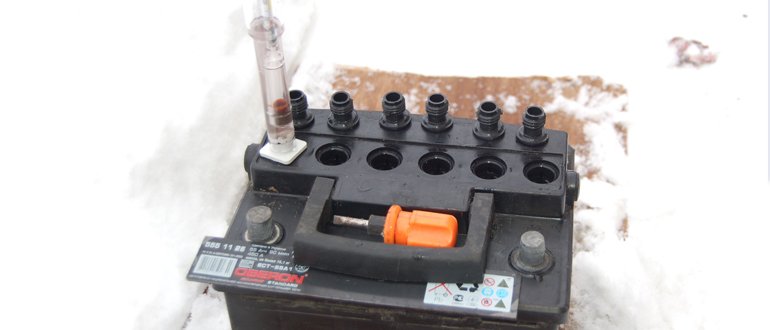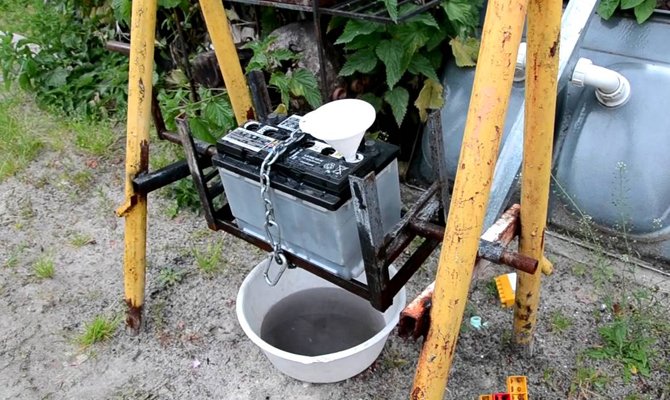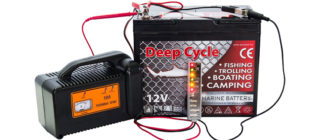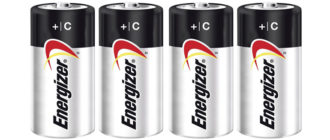Modern batteries can last up to 10 years before replacing them. Unfortunately, even such elements cannot be fully protected from premature failure, especially as a result of sulfation plates or shorting cans. The latter problem is especially relevant if the battery is operated in difficult conditions.
Content
Because of what it can close the battery jar
If the operated battery has already served the period recommended by the manufacturer, then the closure of the can is simply one of the causes of the “death” of the battery. In a new battery, such a malfunction will happen most often due to marriage. If you have a receipt for the goods and a valid warranty period, you can contact the store where the battery was purchased.
The jar can also be closed as a result of improper battery operation. For example, if it was not reliably fixed in a regular place, but the car was operated at high speed on impassability, then from active shocks and shaking the active mass of the plates may crumble and a short circuit will occur.
If the battery is dropped when carrying it, then in this case the internal elements may be damaged, because of which one or several sections will also be short-circuited. Side impacts are no less dangerous, therefore, maximum caution should be exercised, because in addition to failure during acid depressurization of the case, acid may leak out.
Most often, the closure of the cans comes from the fact that they do not have time to fill in the electrolyte in time. After all, if it falls too low, then the plates will become bare and crumble. Accidentally connected positive contacts with the mass can also occur in the form of destruction and shedding of plates, which sooner or later will lead to a short circuit.
In winter, this problem can occur when storing a discharged battery in an unheated room or outdoors. A frozen electrolyte with great effort will compress the grids, which, unable to withstand the load, will completely collapse. Dropped or displaced metal will cause a short circuit.
Signs of a closed battery
If a fully charged battery stops starting the engine, while the wires are qualitatively connected to the terminals and there are no problems with the electrics, then almost always this “behavior” is connected with the closure of the can.
Excessive heating of the battery can also indicate damage of this type, because if one compartment fails, whole elements will be subjected to increased load.
Symptoms such as a low inrush current and a high battery temperature often leave no doubt that one of the cans is inoperative, but it is advisable to conduct a series of experiments, including using measuring instruments, to confirm the “diagnosis”.
How to check for a short circuit
The easiest way to check for a short circuit is a serviced or low-maintenance battery. To do this, just unscrew all the covers and put the battery on charge. At some point, serviceable banks will begin to boil, while in a closed one nothing will happen at all. By the way, under load, on the contrary, a closed jar will boil.
If after that we measure the density of the electrolyte in each jar, then it turns out that in good condition there will be a normal value (~ 1.27), and in the dead float it will float to the very minimum value (slightly more than unity). In addition, when the engine starts, a voltage drop of up to 9 volts will appear.
Note! Indirect evidence will be a white coating, which can be observed in banks through holes, this is sulfation.
IN maintenance free batteries There is no open access to banks, so determining the closure will be a little more difficult. The easiest way to determine the voltage drop to 9 volts when starting the engine. This will not be enough to start and the engine simply will not start. When charging, the battery voltage will not rise above 10.7 volts.
Should I try to repair the battery
If the battery is under warranty, then it should be returned to the store in which it was purchased, since it is possible factory defects. They will have to conduct an examination and if it is established that the battery failed due to the fault of the car owner, then it will be replaced with a new one.
In old batteries - this is an "age-related disease." In this case, the most appropriate solution would be to return the battery to the scrap and purchase a new one. In the event that the malfunction is caused by crumbled active substance, the battery can be restored.
If the case is made of light plastic, it is easy to notice an accumulation of dark mass in the lower part of the closed jar, which should be removed. The efforts to restore the battery by washing the can from debris are justified only if the remaining battery cells are in good condition.
Important! If the jar is closed, then it is better not to restore the battery and buy a new one, as it will return to its previous capacity, starting current and voltage will not work.
How to restore a closed battery
Before proceeding with an independent battery repair, you must take the necessary precautions. It is advisable to carry out all work in a well-ventilated area, and use rubberized apron, gloves and glasses to protect against sulfuric acid.
You can repair the product in the following sequence:
- Remove the battery from the machine.
- Understand which section does not show signs of life.
- Mark the border of the jar on the battery cover with a marker.
- If the battery is serviced, then use a rubber bulb or a hydrometer to remove the maximum amount of electrolyte from the can.
- Using a hacksaw blade, saw off the previously marked section of the lid, after which the access to the plates will open. If an unattended product is disassembled, then at this stage, liquid should also be removed from the opened compartment.
- To remove a damaged battery, it is necessary to saw off the jumpers connecting it to other banks. For this purpose, it is required to slightly cut the plastic covering these elements, and then carefully separate the lead elements with a hacksaw blade.
- Carefully, using small wire hooks, the block of plates and separators is pushed and removed from the battery case.
- Then you need to prepare a plastic container with distilled water, into which the extracted part is dipped several times.
- The jar should also be washed thoroughly with distilled water.
- If the plates are not badly damaged, then they can be installed back, otherwise you need to pick up a similar element from another battery of the same capacity.
- When installing a “native” or borrowed can, the polarity must be observed. Only in this case can we hope for the normal operation of the battery after repair.
- With a powerful soldering iron, the lead parts are soldered. Also, this tool can be used to install previously cut a piece of plastic cover. If the battery is maintenance free, then before reliably closing access to the bank, a sufficient amount of electrolyte is poured into it. In serviced batteries, this procedure can be performed after the complete completion of the soldering work.
The repaired battery should be charged. Then the product is checked under load.If a fully charged battery will cope with starting the engine, then, with a high-quality soldering of metal, such a battery can work for several more years without any complaints.
Note! If it was possible to restore the battery, then it is not recommended to put it on a car, it is better to use it somewhere in the household as a backup power source.









